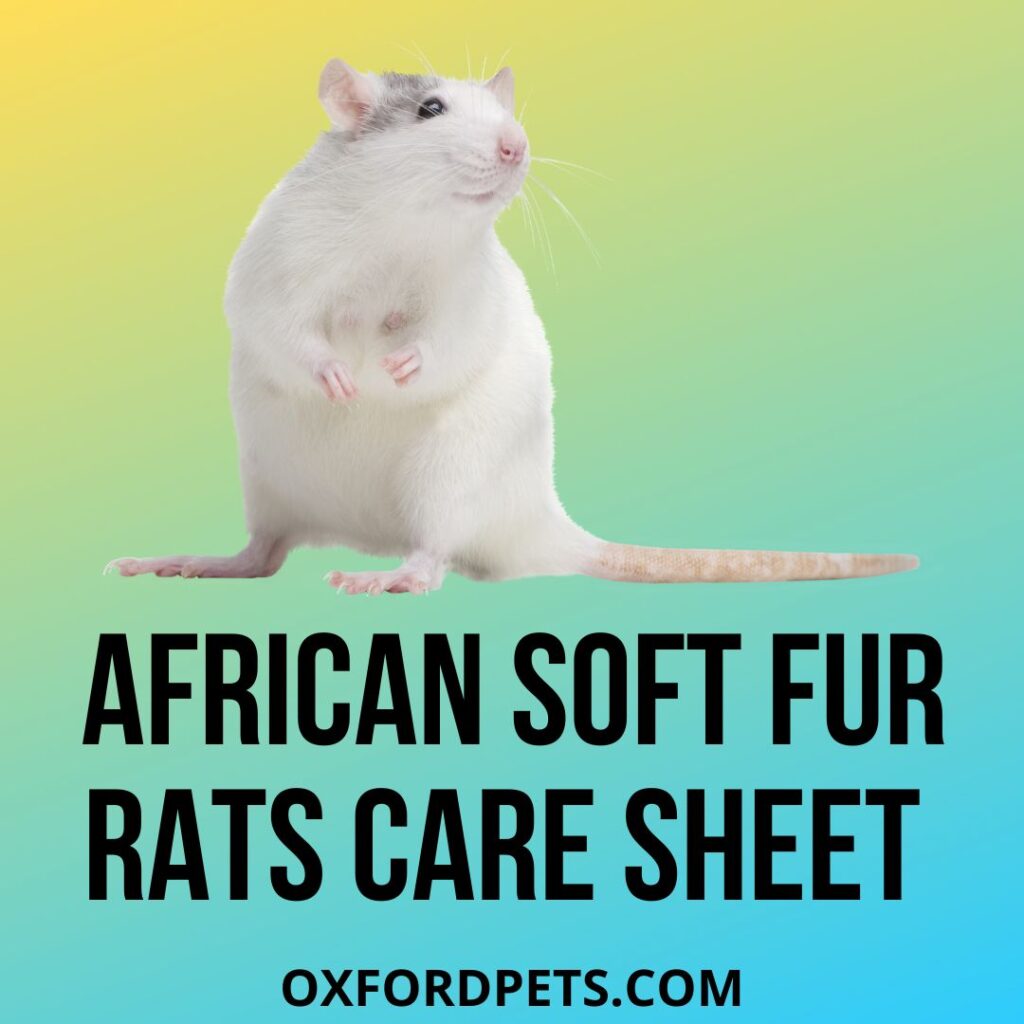Adopting or buying an African soft fur rat is easy. However, keeping them safe and satisfied is a bit tricky. Hence, here is everything you must know before having an African Soft Fur Rat. here We have a comprehensive guide on African Soft Fur Rat: Care, Info and Facts
Contents
- African Soft Fur Rat Basic Info
- How do you take care of African soft fur rats?
- How long do African soft fur rats take to grow?
- Is an African soft fur rat a rat or a mouse?
- Do African soft furs make good pets?
- How long do African soft furs live?
- Do African soft fur rats smell?
- What vegetables can African soft fur rats eat?
- How often should I bathe my rat?
African Soft Fur Rat Basic Info
| Name | African Soft Fur Rat |
| Size | 5-6 inches |
| Species | Mastomys natalensis |
| Weight | 42 grams |
| Colours | Pied markings, cinnamon, agouti brown, etc |
| Diet | Omnivorous |
| Location | Africa |
| Lifespan | 2-3 years |
How do you take care of African soft fur rats?

African soft fur rats’ housing needs
The cage you chose for your African soft fur rat is highly important for their well-beingness. This is the place where he will spend most of his time. Therefore, you can go for a bigger cage to provide good space for moving around.
Usually, these rats should have 12”x12”x12” space in the cage. Therefore, you can opt for this size with different housings like wire cages, glass aquariums, and homemade cages.
Wire cages For African soft fur rats
Wire cages are most preferred. You can go for multi-level, all-metal pet cages. Make sure that the bar spacing is around half an inch to prevent escape. This is because a baby African soft fur rat can easily go through bar spacing.
Wire cages give good ventilation, huge space to climb, and great opportunities to provide hanging toys. Moreover, wire cages are very easy to clean. You just have to shower it with soap and water.
Glass aquarium For African soft fur rats
A glass aquarium or tank is a potential house for African soft fur rats. A 30″ x 12″ x 12″ long aquarium is enough for 2 rats. However, a 20″ x 10″ x 12″ long space will not be enough for more than a year.
Glass aquariums or tanks have their pros and cons. The pros include unobstructed viewing for your fur ball. Moreover, you can also pick the best bedding for burrowing. Make sure that the tank is well-ventilated. The cons are that you can’t be creative with it and it is hard to clean it.
Homemade Cages & African soft fur rats
You can make it as you want. You can make it big, with stairs, burrows, dens, etc. It totally depends on your budget.
The most common homemade cages are storage bins or sterile cages. They are easy to clean, effective, and affordable.
- Buy the storage tub in your budget from a retail store
- Buy a small roll of ½ x ½ inch wire mesh
- Using the box cutter, cut out the inside.
- Glue the sized wire mesh and cut out hole properly. And you are ready to use it.
Socializing Your African soft fur rats
African soft fur rats are very social animals. They need a company to be happy. If you keep them alone, they may become depressed. Hence, make sure you bring at least two African soft fur rats home. Moreover, 3 African soft fur rats per colony is a good choice. Male African soft fur rats can live together without any problem.
Moreover, fancy rats cannot live with mice. However, this case is not the same with African soft fur rats. They can live with mice. Many owners keep female African soft fur rats with male mice. And they get along with each other very well.
What can African soft fur rats eat?
African soft fur rats are omnivores and eat seeds, veggies, and mealworms. They need access to water and food all the time in captivity. In the wild, they fetch food by themselves. Predators of African soft fur rats include reptiles like python.
Cohabiting with fancy mice
Fancy mice can be highly territorial when living with others. The best way to solve this is to introduce African soft fur rats of the opposite gender. Female African soft fur rats cannot breed with male fancy mice. However, they can still socialise together.
This is, in fact, good for the African soft fur rats. They love to be around other rats and mice. This makes them happy and healthy.
What kind of bedding Is Apt for African soft fur rats?
Do not use pine or cedar as bedding. It is unhealthy for all small animals. Moreover, it can trigger health issues like headaches. There are better options than these.
Aspen shavings are safe and effective, plus they are not at all costly. Moreover, you can also use recycled paper product litter.
DO NOT USE CEDAR or PINE! This is not healthy for ALL small pets! It often triggers a range of health issues, and is just not worth the risk and headache! There are better alternative litters available.
Additionally, you can use fleece material (shredded or cut). You can wash them once a week and reuse them. In fact, this is very comfortable bedding for African soft fur rats. Moreover, you can be creative with patterns and colours.
What toys can you give African soft fur rats?
The African soft fur rat needs a food bowl, water bowl, litter house, and bedding. However, you also need things that entertain them. Also, exercising keeps them active. For this, you can get a metal running wheel to run and release excess energy. Other things you can purchase include hammocks from pet stores, cardboard boxes, and paper towel tubes.
What temperature is suitable for African soft fur rats?
The African soft fur rats go well at temperatures between 68 – 74 degrees Fahrenheit. This is a normal room temperature. Therefore, there is no need to supply heat additionally.
How long do African soft fur rats take to grow?
They get sexual maturity between 2-3 months. The gestation period is not more than two days. They ovulate every 4 days. This results in a new litter every 3 to 4 weeks.
They sexually mature between 2-3 months. Their gestation period is usually no more than 21 days and they ovulate every 4 days which usually results in a new litter every 3-4 weeks.
Is an African soft fur rat a rat or a mouse?
An African soft fur rat is a natal multimammate mouse. Sometimes it is also known as a Natal multimammate rat. However, they are not exactly rats or mice. They actually care for rodents from the family Muridaue and genus Mastomys.
Do African soft furs make good pets?
Yes. African soft fur rats make good pets. However, reptile breeders use them as a food source as they multiply quickly.
How long do African soft furs live?
The African soft fur rats live for up to 3 years. They are omnivorous animals and eat mealworms, veggies, and fruits.
Do African soft fur rats smell?
No, they have little to no smell. Moreover, you can keep them in homemade cages, aquariums, and wired cages.
What vegetables can African soft fur rats eat?
The African soft fur rats eat cucumber, asparagus, zucchini, and broccoli. Moreover, they can also consume squash and pumpkin. Other root veggies like parsnip, rutabaga, and potato are fine for them. They can also eat parsley, fennel, and fresh basil.
How often should I bathe my rat?
Unless your African soft fur rat gets dirty, you do not need to bathe him frequently. When bathed, they lose some natural oils from their body that save them from external infections.
